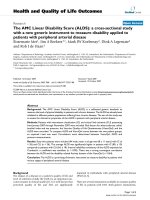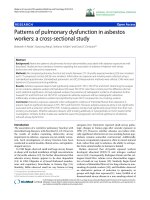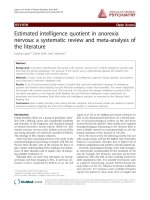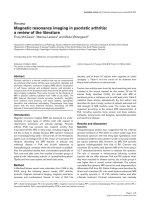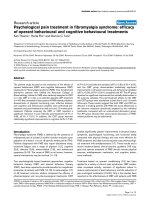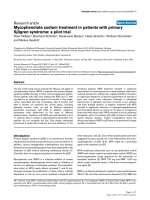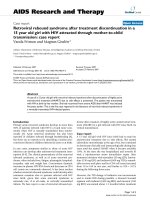Báo cáo y học: " Restless Legs Syndrome in shift workers: A cross sectional study on male assembly worker" doc
Bạn đang xem bản rút gọn của tài liệu. Xem và tải ngay bản đầy đủ của tài liệu tại đây (218.61 KB, 7 trang )
BioMed Central
Page 1 of 7
(page number not for citation purposes)
Journal of Circadian Rhythms
Open Access
Research
Restless Legs Syndrome in shift workers: A cross sectional study on
male assembly workers
Akbar Sharifian
1
, Marjan Firoozeh*
1
, Gholamreza Pouryaghoub
1
,
Mehran Shahryari
1
, Mohsen Rahimi
2
, Mohammad Hesamian
2
and Ali Fardi
2
Address:
1
Department of Occupational Medicine, Tehran University of Medical Sciences, Tehran, Iran and
2
HSE Department, SAIPA automobile
manufacturing company, Tehran, Iran
Email: Akbar Sharifian - ; Marjan Firoozeh* - ;
Gholamreza Pouryaghoub - ; Mehran Shahryari - ; Mohsen Rahimi - ;
Mohammad Hesamian - ; Ali Fardi -
* Corresponding author
Abstract
Background: Restless Legs Syndrome (RLS) is a common neurological movement disorder
characterized by symptoms that follow a circadian pattern. Night and rotating shift work schedules
exert adverse effects on functions of the human body by disturbing circadian rhythms, and they are
known to cause sleep disturbances and insomnia. In this paper, we investigate the possible
association between shift work and RLS.
Methods: This cross sectional study was conducted in an automobile manufacturing factory in
Tehran, Iran. A total of 780 male assembly workers were recruited in three groups, each with 260
workers: workers on a permanent morning shift (A) and two different rotating shift schedules (B
and C) with morning, afternoon and night shifts. We used the international RLS study group criteria
for diagnosis of RLS, and the severity scale for severity assessment in subjects with RLS. Self
administered questionnaires were used to gather information on age, smoking, work history,
medical condition, and existence and severity of RLS symptoms.
Results: The prevalence of RLS was significantly higher in rotational shift workers (15%) than
workers with permanent morning work schedule (8.5%). In workers suffering from RLS, we found
greater mean values of age and work experience, higher percentages of drug consumption,
smoking, and co-morbid illnesses compared with subjects who did not have RLS, although these
differences were statistically significant only for age, work experience and drug consumption.
Conclusion: Rotational shift work acts as a risk or exacerbating factor for Restless Legs
Syndrome.
Background
Restless Legs Syndrome (RLS) is a relatively common,
under-diagnosed and treatable neurological disorder
characterized by an irresistible urge to move the limbs to
stop uncomfortable sensory symptoms in the extremities
[1]. Typical symptoms involve the legs, but the arms can
also become involved [2].
Currently, there is no single diagnostic test for RLS. The
disorder is diagnosed clinically by evaluating the patient's
Published: 14 September 2009
Journal of Circadian Rhythms 2009, 7:12 doi:10.1186/1740-3391-7-12
Received: 16 March 2009
Accepted: 14 September 2009
This article is available from: />© 2009 Sharifian et al; licensee BioMed Central Ltd.
This is an Open Access article distributed under the terms of the Creative Commons Attribution License ( />),
which permits unrestricted use, distribution, and reproduction in any medium, provided the original work is properly cited.
Journal of Circadian Rhythms 2009, 7:12 />Page 2 of 7
(page number not for citation purposes)
history and symptoms. The clinical features of RLS were
first fully characterized by Ekbom in the 1940s [1,3]. The
most recent RLS diagnostic criteria were developed at a
workshop held by the National Institutes of Health with
the members of the International Restless Legs Syndrome
Study Group (IRLSSG) [4]. Four essential criteria for the
diagnosis of RLS are: 1) a compelling urge to move the
limbs, usually associated with unpleasant sensation in the
legs; 2) symptoms worse or exclusively present at rest,
such as lying or sitting 3) the urge to move or unpleasant
sensations are partially or totally relieved by movement,
such as walking, stretching or rubbing the legs; and 4)
symptoms are worse later in the day or at night [5].
Supportive clinical features for the diagnosis include a
response to dopaminergic agents, a family history of the
disorder, and Periodic Limb Movements (PLMs). PLMs
can be characterized by periodic episodes of stereotyped
limb movements occurring during sleep which are very
common in a variety of sleep disorders including RLS. The
existence of PLMs is, however, not necessary or sufficient
to make the diagnosis of RLS [2].
In epidemiological studies, very different RLS prevalence
rates have been reported. Some discrepancies may be due
to the different diagnostic criteria and methodological
tools applied and the different targeted populations with
varying ethnicities assessed in the surveys. [1,6-8].
A significant number of people worldwide are exposed to
shift work as a result of social needs and economic factors.
The relationship between work schedules and health is
complex and is influenced by characteristics of the work
schedule itself as well as the characteristics of the job, the
worker, and the work environment [9]. Shift work exerts
adverse effects by disturbing circadian rhythms, sleep, and
personal life, and may even be an oxidative stressor
[10,11]. The association between shift work and several
health problems, including reductions in the length and
quality of sleep, gastrointestinal symptoms, and cardio-
vascular diseases is reported in many investigative studies
[12-14].
Symptoms of RLS show a characteristic circadian pattern,
and intensity of subjective complaints of RLS patients may
be modulated by changes in biological markers such as
melatonin [15]. Hence, the disturbance of circadian
rhythms associated with rotating shift work may affect the
prevalence and intensity of RLS symptoms. The main
object of our study was to investigate the potential associ-
ation of shift work with Restless Legs Syndrome.
Methods
Study Design
This cross sectional study was conducted in an automo-
bile manufacturing factory located in Tehran (the capital
city of Iran). Factory workers cover morning (7 am - 3
pm), afternoon (3 pm - 11 pm) and night (11 pm - 7 am)
shifts. Employees assigned to schedule A are required to
work only morning shifts whereas employees assigned to
schedules B and C follow a rotating shift schedule. Specif-
ically, employees assigned to schedule B rotate on a six
week schedule, where they alternate between the morning
and afternoon shifts for 5 weeks, and they are required to
work the night shifts in week 6. Employees assigned to
schedule C rotate on a three week schedule, where they
work the morning shifts for week one, followed by the
afternoon shifts and night shifts on weeks two and three,
respectively.
A total of 1700 assembly workers were working in the fac-
tory at the time of sampling, and a sample of 780 male
workers (260 workers in each work schedule) was selected
from them, by using a simple randomization. No specific
exclusion criteria were used. Each subject signed an
informed consent document after the goals of the study
were fully explained.
The study consisted of self administered questionnaires
completed by participants to provide information on the
following items: (i) age, (ii) smoking habits, (iii) medical
history for co-morbid illnesses (anemia, diabetes melli-
tus, chronic kidney disease and Parkinson's disease), (iv)
consumption history of the drugs which are known to
aggravate or induce RLS (antidepressants, sedating anti-
histamines, dopamine receptor antagonists including
anti-emetic and antipsychotic medications), (v) working
history, including the number of years employed as a
worker in this factory and work schedule. To assess the
existence of RLS we used the four minimal IRLSSG clinical
criteria, provided in the Background section, as a screen-
ing tool in this paper.
All the participants who fulfilled the IRLSSG criteria were
also asked to fill in a form that included questions for
assessing the existence of PLMs, history of RLS in their first
degree relatives, sleep disturbance of their bed partners
due to RLS and the IRLSSG rating scale [16]. Severity of
RLS can be classified as mild (≤10 in IRLSSG rating scale),
moderate (11-20), severe (21-30) and very severe (31-40).
Data analysis
For statistical analysis, we used SPSS 11.5 for Windows.
Descriptive statistics were used to characterize the study
population. Differences between mean values of continu-
ous variables (age and years of service) were tested using t
tests, while proportions for dichotomous variables were
calculated with chi-square and Fisher exact tests. Associa-
tion of RLS with working schedule was examined by
binary logistic regression. Odds ratios with the corre-
sponding 95% confidence intervals were calculated after
Journal of Circadian Rhythms 2009, 7:12 />Page 3 of 7
(page number not for citation purposes)
adjustment for Age and drug consumption. A P-value of
less than 0.05 was considered to be significant.
Results
Twelve participants did not completely fill in the ques-
tionnaire, and their data were not included in the analy-
ses. The analysed dataset included 260 workers assigned
to group A, 258 shift workers assigned to group B, and 250
shift workers assigned to group C.
Overall prevalence of RLS among the workers was 12.8%
(n = 98). Among workers classified as having RLS, 69
(70.4%) reported having PLMs, and 19 (19.4%) had fam-
ily history of RLS in their first degree relative. In addition
to health problems associated with RLS, existence of RLS
also affected the quality of life of the individual's bed part-
ner. In our study 60 out of 98 (61.2%) patients reported
sleep disturbance of their bed partners. According to the
IRLSSG severity scale, 62 out of 98 (63.3%) subjects indi-
cated a severe or very severe RLS (IRLSSG rating scales
greater than or equal to 21).
The percentages of current cigarette smokers, chronic dis-
orders, and drug consumption were higher in RLS patients
compared with subjects who did not have RLS, but the dif-
ferences were not statistically significant for cigarette
smoking and chronic disorders. Comparisons of demo-
graphic and clinical characteristics of RLS patients and
control group (non-RLS workers) are shown in Table 1.
Workers in neither group reported having Parkinson's dis-
ease.
The prevalence of RLS was 8.5% (n = 22 out of 260) in
group A, 14.7% (n = 38 out of 258) in group B and 15.2%
(n = 38 out of 250) in group C. Comparison of RLS prev-
alences using chi square test showed significant differ-
ences between groups B and A (p = 0.03), groups C and A
(p = 0.02), and groups B&C and A (p = 0.01). Thus, the
Table 1: Comparison of some variables between Restless Legs Syndrome (RLS) patients and control subjects
Variable RLS (n = 98) Control (n = 670) P Total (n = 768)
Age (year)
Mean (SD) 35.2 (5.9) 32.7 (5.8) <0.001 33 (5.9)
Range 24-50 20-58 20-58
Work experience (year)
Mean (SD) 11.8 (5.3) 8.9 (4.7) <0.001 9.3 (4.9)
Range 2-25 0.5-27 0.5-27
Current smokers, n (%) 19 (19.4) 87 (12.9) 0.115 106 (13.8)
Chronic disorders, n (%)
Anemia 6 (6.1) 24 (3.6) 0.258 30 (3.9)
Diabetes mellitus 4 (4.1) 18 (2.7) 0.51 22 (2.9)
Chronic kidney disease 1 (1) 2 (0.3) 0.336 3 (0.4)
Total 11 (11.2) 44 (6.6) 0.097 55 (7.2)
Drug consumption, n (%)
Antihistamines 16 (16.3) 29 (4.32) <0.001 45 (5.85)
Antidepressants 6 (6.1) 23 (3.43) 0.248 29 (3.77)
Dopamine antagonist 2 (2) 15 (2.23) 1.0 17 (2.21)
Total 24 (24.4) 67 (10) <0.001 91 (11.8)
Journal of Circadian Rhythms 2009, 7:12 />Page 4 of 7
(page number not for citation purposes)
prevalence of RLS was significantly higher in rotational
shift workers (groups B and C) than workers with perma-
nent morning work schedule (group A) (see Table 2).
Comparisons of RLS severity and weekly occurrence
between groups are shown in Table 3. According to a cut-
off score of 21 to distinguish subjects with severe and very
severe symptoms from moderate and mild ones in sever-
ity assessment of RLS, our data reveal that workers catego-
rized as having severe or very severe RLS (severity score ≥
21) are not more common among rotational shift workers
(groups B and C) than among workers with permanent
morning work schedule (group A) (chi square test, P =
0.2). Also, the number of rotational shift workers (groups
B and C) who suffer from RLS on four or more days a week
is not significantly larger than the number of workers with
permanent morning work schedule (group A) (P = 0.33).
Discussion
This study is one of very few to investigate the relationship
between different shift work patterns and the occurrence
of RLS. Among the group of rotational shift workers, we
compared two rotational shift patterns having different
night shifts. Work during the night shift is much more
likely to have adverse effects on health than work during
afternoon shifts because it disrupts the circadian organiza-
tion of the body [17,18]. The main contribution of the
current study is the use of the IRLSSG criteria for the diag-
nosis of RLS and the use of IRLSSG severity scale to assess
the severity of RLS for a group of shift workers. Because
our subjects had very similar job tasks in the factory, they
also had relatively similar socioeconomic status.
Epidemiological surveys have shown that RLS is a com-
mon neurological movement disorder. In the reports of
previous Asian studies, RLS prevalence rates ranged from
0.1% in a primary healthcare centre population aged 21
years and older in Singapore to 12.1% in a large Korean
cohort [1,19,20]. This discrepancy is probably due to the
differences in the demographic characteristics and assess-
ment methods used in the different studies. In our study,
the overall prevalence of RLS in male assembly workers
was 12.8%. Of course, the fact that our study was con-
ducted with a specific population of factory workers, we
cannot generalize the prevalence rate to the general popu-
lation.
Although we found a higher percentage of cigarette smok-
ers among the RLS individuals than in controls, the differ-
ence was not statistically significant (P = 0.115). The
possible relation between cigarette smoking and increased
risk of RLS has also been investigated in previous studies
with inconsistent results [21-23]. A reliable explanation
for such a discrepancy may be due to the different meas-
urement criteria used to determine smoking habits. We
did not separate heavier from lighter smokers; thus, quan-
titative assessment of cigarette smoking may better clarify
the above-mentioned relationship, if it exists.
Similarly, although we found higher percentages of
chronic disorders among RLS individuals than among
controls the differences were not statistically significant
(see Table 1). The process of assessment of co-morbid ill-
nesses, in our study, was performed through participants'
self reports and was not verified with laboratory tests.
Thus, there is a possibility that the prevalence of co-mor-
bidity is underestimated in our study and the results do
not allow us to infer causality.
We found a greater percentage of antihistaminic and anti-
depressant drug consumption in RLS individuals than in
subjects who did not suffer from RLS, as previously noted
Table 2: Relation of shift work patterns with occurrence of Restless Legs Syndrome (RLS)
Group Suffering from RLS Crude OR [95% CI] Adjusted* OR [95% CI]
No Yes
Day workers (Group A), n (%) 238 (91.5) 22 (8.5) 1.0 Reference 1.0 Reference
Rotational shift workers, n (%)
- Group B 220 (85.3) 38 (14.7) 1.87 [1.07-3.26]
§
1.82 [1.03-3.21]
§
- Group C 212 (84.8) 38 (15.2) 1.94 [1.11-3.38]
§
1.98 [1.12-3.51]
§
- Groups B and C 432 (85) 76 (15) 1.9 [1.15-3.14]
§
1.89 [1.13-3.16]
§
Notes: Group B: workers who follow a work schedule which consists of weekly rotation between morning and afternoon shifts for five weeks in a
row, followed by one week of night shifts on week six; Group C: workers who follow a work schedule which consists of weekly rotation between
morning, afternoon and night shifts; n = number; OR = odds ratio; CI = confidence interval
* This analysis was adjusted by age and drug consumption.
§
P-value < 0.05
Journal of Circadian Rhythms 2009, 7:12 />Page 5 of 7
(page number not for citation purposes)
by others [24]; however, only the difference in antihista-
mine consumption was statistically significant.
We found a statistically significant association between
rotational shift work and RLS, especially in the group that
included more night shifts (Group C) (see Table 2). The
percentage of workers suffering from RLS was about twice
as high in rotational shift workers (groups B and C) than
in day workers (group A). In an epidemiological survey in
central Greece, the percentage of shift workers was higher
in RLS individuals than in individuals who did not suffer
from RLS, although the difference was not statistically sig-
nificant [23]. In another study that investigated the asso-
ciation between shift work and sleep disorders among
police officers from Buffalo, New York (that did not use
IRLSSG criteria), the prevalence of RLS was 134 percent
higher among women night shift workers than among
women workers on other shifts, although the difference
was not statistically significant after adjustment for other
covariates, and among men there was not any association
between night shift work and RLS [25]. In an epidemio-
logical study conducted in five European countries with
the aim of documenting the prevalence of RLS and PLMs
in the general population and identifying factors associ-
ated with these conditions, authors reported that the prev-
alence of RLS was 5.5% and the prevalence of PLMs was
3.9%, while 18.5% of RLS subjects also had PLMs. Shift or
night work was significantly associated with PLMs (OR =
1.4; 95 percent CI = 1.06 - 1.88; P < 0.05) but not with RLS
(OR = 0.72; 95 percent CI = 0.50 - 1.05) [26].
Several lines of evidence implicate a dopaminergic pathol-
ogy in RLS, the strongest of which comes from the phar-
macological response of RLS symptoms to dopaminergic
agents and aggravation of its symptoms by dopamine
blocking type agents [27-29]. Also, it has been reported
that higher levels of dopamine and related compounds
are found in cerebro-spinal fluid (CSF) in the day time
than at night time, with a peak in dopamine at 10 a.m.
and a peak for homovanillic acid (HVA) at 2 p.m. [30].
Such circadian variation is consistent with the circadian
pattern of RLS symptoms aggravation. Hence, the associa-
tion between rotational shift work and RLS may be medi-
ated by disruption of circadian rhythmicity.
The role of oxidative stress in the pathological process
underlying Parkinson's disease has been reported in other
studies [31,32]. Because of similar features in RLS and Par-
kinson's disease, such as dopaminergic dysfunction and
response to dopaminergic agents, it has been suggested
that these two diseases may share a common pathophysi-
ology [33,34]. Since shift work has been shown to induce
oxidative stress in the human body [11,35,36], it is possi-
ble that oxidative stress mediates the association between
rotational shift work and RLS.
Our results indicate that more work experience is a risk
factor for RLS, possibly because of aging, which is a
known risk factor for RLS [6,20,37]. To the best of our
knowledge, the relationship between work conditions
and job tasks with RLS incidence had not been investi-
gated in previous studies. More experience in assembly
work and monotonous manual tasks may have a role in
the positive correlation observed between work experi-
ence and RLS prevalence, although our results do not pro-
vide sufficient information to evaluate such a hypothesis.
Future studies investigating the association between shift
work and RLS will be strengthened by increases in sample
sizes, by objective laboratory assessment of possible co-
morbidities known as causes of RLS, by assessment of the
duration of symptoms, and by the use of a prospective
study design.
Table 3: Comparison of Restless Legs Syndrome severity and weekly occurrence between groups
Group Severity Scale Weekly occurrence
< 21 ≥ 21 < 4 day ≥ 4 day
Day workers (Group A), n (%) 11 (50) 11 (50) 13 (59.1) 9 (40.9)
Rotational shift workers, n (%)
- Group B 14 (36.8) 24 (63.2) 16 (42.1) 22 (57.9)
- Group C 11 (28.9) 27 (71.1) 18 (47.4) 20 (52.6)
- Groups B and C 25 (32.9) 51 (67.1) 34 (44.7) 42 (55.3)
Notes: Group B: workers who follow a work schedule which consists of weekly rotation between morning and afternoon shifts for five weeks in a
row, followed by one week of night shifts on week six; Group C: workers who follow a work schedule which consists of weekly rotation between
morning, afternoon and night shifts.
Journal of Circadian Rhythms 2009, 7:12 />Page 6 of 7
(page number not for citation purposes)
Conclusion
It can be concluded that rotational shift work may act as a
risk or exacerbating factor for Restless Legs Syndrome,
which is known to have adverse effects on patients' work
performance and quality of life [38]. Although effective
and safe treatments exist for RLS, most cases remain undi-
agnosed. Therefore, screening of shift workers for RLS in
their routine periodic examination may be valuable. Fur-
ther research is necessary to corroborate the associations
observed in this study.
Abbreviations
RLS: restless legs syndrome; IRLSSG: international restless
legs syndrome study group; PLMs: periodic limb move-
ments; OR: odds ratio; CI: confidence interval; CSF: cere-
bro-spinal fluid; HVA: homovanillic acid.
Competing interests
The authors declare that they have no competing interests.
Authors' contributions
ASH helped with the conception and design of the study,
helped to collect the data, and helped to draft the manu-
script. MF helped with the conception and design of the
study, helped to collect the data, participated in the data
analysis and interpretation, and helped to draft the man-
uscript. GHP and MSH helped with the conception and
design of the study and helped to draft the manuscript.
MR, MH and AF helped with the conception and design of
the study and helped in study coordination and the data
collection.
Acknowledgements
We hereby gratefully acknowledge the assistance of Dr. Amir Haddadi, Dr.
Leila Ghalichee, Mr. Hourzad, Mr. Ramezani and the staff at SAIPA automo-
bile manufacturing company, Tehran, Iran.
References
1. Barriere G, Cazalets JR, Bioulac B, Tison F, Ghorayeb I: The restless
legs syndrome. Prog Neurobiol 2005, 77(3):139-165.
2. Avidan AY: Motor Disorders of Sleep and Parasomnias. In
Handbook of Sleep Medicine 1st edition. Edited by: DeStefano FR,
Scheidt S. Philadelphia: Lippincott Williams & Wilkins; 2006:112-119.
3. Ekbom K: Restless legs: a clinical study. Acta Med Scand 1945,
158(Suppl):1-123.
4. Allen RP, Picchietti D, Hening WA, Trenkwalder C, Walters AS,
Montplaisi J, the participants in the Restless Legs Syndrome Diagnosis
and Epidemiology workshop at the National Institutes of Health in
collaboration with members of the International Restless Legs Syn-
drome Study Group: Restless legs syndrome: Diagnostic crite-
ria, special considerations, and epidemiology: A report from
the restless legs syndrome diagnosis and epidemiology work-
shop at the National Institutes of Health. Sleep Med 2003,
4(2):101-119.
5. Walters AS: Toward a better definition of the restless legs syn-
drome. The International Restless Legs Syndrome Study
Group. Mov Disord 1995, 10(5):634-642.
6. Allen RP, Walters AS, Montplaisir J, Hening W, Myers A, Bell TJ,
Ferini-Strambi L: Restless legs syndrome prevalence and
impact: REST general population study. Arch Intern Med 2005,
165:1286-1292.
7. Zucconi M, Ferini-Strambi L: Epidemiology and clinical findings
of restless legs syndrome. Sleep Med 2004, 5:293-299.
8. Vijver DA Van De, Walley T, Petri H: Epidemiology of restless
legs syndrome as diagnosed in UK primary care. Sleep Med
2004, 5:435-440.
9. Barton J, Spelten E, Totterdell P, Smith L, Folkard S, Costa G: The
standard shiftwork index, a battery of questionnaires for
assessing shift work related problems. Work Stress 1995,
9(1):4-30.
10. Caruso C, Rosa RR: Shift Work and Long Work Hours. In Envi-
ronmental and Occupational Medicine 4th edition. Edited by: Rom WN.
Philadelphia: Lippincott Williams & Wilkins; 2007:1359-1362.
11. Sharifian A, Farahani S, Pasalar P, Gharavi M, Aminian O: Shift work
as an oxidative stressor. J Circadian Rhythms
2005, 3:15.
12. Knutsson A: Health disorders of shift workers. Occup Med (Lond)
2003, 53:103-108.
13. Caruso CC, Lusk SL, Gillespie BW: Relationship of work sched-
ules to gastrointestinal diagnosis, symptoms, and medica-
tion use in auto factory workers. American J Indust Med 2004,
46(6):586-98.
14. Boggild H, Knutsson A: Shift work, risk factors and cardiovascu-
lar disease. Scand J Work Environ Health 1999, 25:85-99.
15. Michaud M, Dumont M, Selmaoui B, Paquet J, Fantini ML, Montplaisir
J: Circadian rhythm of restless legs syndrome: relationship
with biological markers. Ann Neurol 2004, 55:372-380.
16. The International Restless Legs Syndrome Study Group: Validation
of the International Restless Legs Syndrome Study Group
Rating Scale for restless legs syndrome. Sleep Med 2003,
4(2):121-132.
17. Monk TH: What can the chronobiologist do to help the shift
worker? J Biol Rhythms 2000, 15(2):86-94.
18. Sack RL, Blood ML, Lewy AJ: Melatonin rhythms in night shift
workers. Sleep 1992, 15(5):434-41.
19. Tan EK, Seah A, See SJ, Lim E, Wong MC, Koh KK: Restless legs
syndrome in an Asian population: a study in Singapore. Mov
Disord 2001, 16:577-579.
20. Kim J, Choi C, Shin K, Yi H, Park M, Cho N, Kimm K, Shin C: Prev-
alence of restless legs syndrome and associated factors in the
Korean adult population: the Korean Health and Genome
Study. Psychiatry Clin Neurosci 2005, 59:350-353.
21. Lavigne GL, Lobbezoo F, Rompre PH, Nielsen TA, Montplaisir J: Cig-
arette smoking as a risk factor or an exacerbating factor for
restless legs syndrome and sleep bruxism. Sleep 1997,
20:290-293.
22. Hogl B, Kiechl S, Willeit J, Saletu M, Frauscher B, Seppi K, Muller J,
Rungger G, Gasperi A, Wenning G, Poewe W: Restless legs syn-
drome: a community-based study of prevalence, severity,
and risk factors. Neurology 2005, 64:1920-1924.
23. Hadjigeorgiou GM, Stefanidis I, Dardiotis E, Aggellakis K, Sakkas GK,
Xiromerisiou G, Konitsiotis S, Paterakis K, Poultsidi A, Tsimourtou V,
Ralli S, Gourgoulianis K, Zintzaras E: Low RLS prevalence and
awareness in central Greece: an epidemiological survey. Eur
J Neurol 2007, 14(11):1275-1280.
24. Gamaldo MD, Earley CJ: Restless Legs Syndrome: A Clinical
Update. CHEST 2006, 130:1596-1604.
25. Charles LE, Burchfiel CM, Fekedulegn D, Vila B, Hartley TA, Slaven J,
Mnatsakanova A, Violanti JM: Shift work and sleep: the Buffalo
Police health study, Policing. An International Journal of Police Strat-
egies & Management 2007, 30(2):215-227.
26. Ohayon MM, Roth T: Prevalence of restless legs syndrome and
periodic limb movement disorder in the general population.
J Psychosom Res 2002, 53:547-554.
27. Allen R: Dopamine and iron in the pathophysiology of restless
legs syndrome (RLS). Sleep Med 2004, 5(4):385-391.
28. Montplaisir J, Karrasch J, Haan J, Volc D: Ropinirole is effective in
the long-term management of restless legs syndrome: a ran-
domized controlled trial. Mov Disord 2006, 21(10):1627-35.
29. Winkelmann J, Schadrack J, Wetter TC, Zieglgänsberger W, Trenk-
walder C: Opioid and dopamine antagonist drug challenges in
untreated restless legs syndrome patients. Sleep Med 2001,
2:57-61.
30. Poceta JS, Parsons L, Engelland S, Kripke DF: Circadian rhythm of
CSF monoamines and hypocretin-1 in restless legs syn-
drome and Parkinson's disease. Sleep Med 2009, 10:129-33.
31. Jenner P, Dexter DT, Sian J, Schapira AH, Marsden CD: Oxidative
stress as a cause of nigral cell death in Parkinson's disease
and incidental lewy body disease. The Royal Kings and
Publish with BioMed Central and every
scientist can read your work free of charge
"BioMed Central will be the most significant development for
disseminating the results of biomedical research in our lifetime."
Sir Paul Nurse, Cancer Research UK
Your research papers will be:
available free of charge to the entire biomedical community
peer reviewed and published immediately upon acceptance
cited in PubMed and archived on PubMed Central
yours — you keep the copyright
Submit your manuscript here:
/>BioMedcentral
Journal of Circadian Rhythms 2009, 7:12 />Page 7 of 7
(page number not for citation purposes)
Queens Parkinson's Disease Research Group. Ann Neurol
1992, 32(Suppl):S82-87.
32. Jenner P, Olanow CW: Oxidative stress and the pathogenesis of
Parkinson's disease. Neurology 1996, 47(6 Suppl 3):S161-170.
33. Tan EK: Restless Legs Syndrome and Parkinson's disease: Is
there an etiologic link? J Neurol 2006, 253(Suppl 7):VII33-37.
34. Garcia-Borreguero D, Odin P, Serrano C: Restless legs syndrome
and PD: A review of the evidence for a possible association.
Neurology 2003, 61(6 Suppl 3):S49-55.
35. Ishihara I, Nakano M, Ikushima M, Hara Y, Yoshimine T, Haraga M,
Nakatani J, Kawamoto R, Kasai H: Effect of work conditions and
work environments on the formation of 8-OH-dG in nurses
and non-nurse female workers. J UOEH 2008, 30(3):293-308.
36. Kasai H, Iwamoto-Tanaka N, Miyamoto T, Kawanami K, Kawanami S,
Kido R, Ikeda M: Life style and urinary 8-hydroxydeoxyguano-
sine, a marker of oxidative DNA damage: effects of exercise,
working conditions, meat intake, body mass index, and
smoking. Jpn J Cancer Res 2001, 92(1):9-15.
37. Phillips B, Young T, Finn L, Asher K, Hening WA, Purvis C: Epidemi-
ology of Restless Legs Symptoms in Adults. Arch Intern Med
2000, 160:2137-2141.
38. Abetz L, Allen R, Follet A, Washburn T, Earley C, Kirsch J, Knight H:
Evaluating the quality of life of patients with restless legs syn-
drome. Clin Ther 2004, 26:925-935.
